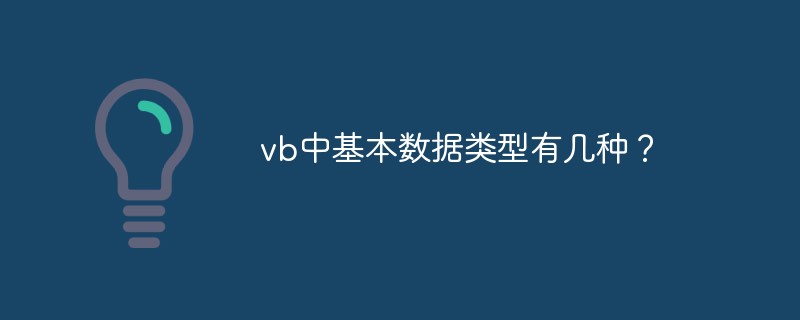Home >Common Problem >How many basic data types are there in vb?
How many basic data types are there in vb?
- 青灯夜游Original
- 2020-12-18 16:28:0340153browse
There are 9 basic data types in VB, namely: character data type, numeric data type (integer, long integer, single-precision floating point, double-precision floating point), currency type , byte type, Boolean type, date type, generic type, unsigned type, object type.

The basic data types provided by VB 6.0 mainly include: character data, numerical data, currency type, byte type, Boolean type, date type, general There are 9 data types such as type, unsigned type, and object type.
1. Character data
Character data (String) is used to define a character sequence. One character is stored in memory using one byte.
2. Numerical data
Numerical data includes 4 types: integer, long integer, and floating point (single precision and double precision).
(1) Integer number
Integer (Integer): It is a number without decimal point, ranging from -32 768 to 3 2 767, using 2 bytes (1 6 bits) to store an integer. A number between -32 678 and 32 767 with a "%" sign at the end also represents an integer data, such as 1 345%, -67%. '
(2) Long integer number
Long integer number (Long): It exceeds the range of 32 768~32 767, and is in the range of -2 147 483 648~2 1 47 483 A number between 647 without a decimal point. A long integer occupies 4 bytes (32 bits) in memory. Numbers between -2 1 47 483 648 and 2 1 47 483 647 have an "&" symbol at the end and are also expressed as a long integer.
(3) Floating point number
Single precision number (Single): It is a real number with a decimal point, and the effective value is 7 digits. Use 4 bytes (32 bits) to store a single-precision number in memory. Usually expressed in exponential form (scientific notation), with "E" or "e" representing the exponent part.
Double precision data (Double): It is also a real number with a decimal point, and the valid value is 1 5 digits. Use 8 bytes (64 bits) to store a double-precision number in memory. Double-precision numbers are usually expressed in exponential form (scientific notation), with "D" or "d" representing the exponent part.
3. Currency type
Currency type (Currency): It is a fixed-point data type set for currency calculation. It has high precision requirements and is accurate to 4 decimal places. Occupies 8 bytes (64 bits) in memory. The value range is between -922 337 203 685 477.5805 and 922 337 203 685 477.5807.
4. Byte type
Byte type: It is a numerical type, stored as a 1-byte unsigned binary number, with a value range of 0~255.
5. Boolean type
Boolean type (Boolean): Boolean data is a logical value, also called a logical type. It is stored in two bytes. It only takes two values, namely 'Frue (true) or False ( Fake).
6. Date type
Date type (Date): Used to represent dates. A date type data uses 8 bytes to store in the memory.
7. Universal type
Universal type (’Variant), also called variant type, is a general, variable data type that can represent any of the above data types. Suppose a is defined as a general variable.
Dim a As Variant
Any type of data can be stored in variable a, for example:
a: --BASIC' - stores a string
a=10 - stores an integer
a=20.5 - stores a real number
a=--08/15/2003'· 'Stores a date data
According to the type of the value assigned to a, the type of variable a constantly changes, which is why it is called a variant type. When a variable has an undefined type, VB automatically defines the variable as a Variant type. Different types of data are stored in Variant variables according to their actual types (for example, assign an integer to a and store it in the memory area as an integer). The user does not need to do any conversion work, VB automatically completes it.
8. Unsigned type
Unsigned type (Decimal): The variable stores a 96-bit (1 2 bytes) unsigned integer form, and is divided by a power of 1 O, which is called the variable ratio factor. This ratio factor determines the number of digits to the right of the decimal point, ranging from 0 to 28.
Note: Currently, the Decimal data type can only be used in variant types (Variant), that is to say, a variable cannot be declared as Decimal. type.
9. Object type
Object type (Object): used to represent graphics, OLE objects or other objects, stored in 4 bytes.
For more programming-related knowledge, please visit: Introduction to Programming! !
The above is the detailed content of How many basic data types are there in vb?. For more information, please follow other related articles on the PHP Chinese website!

